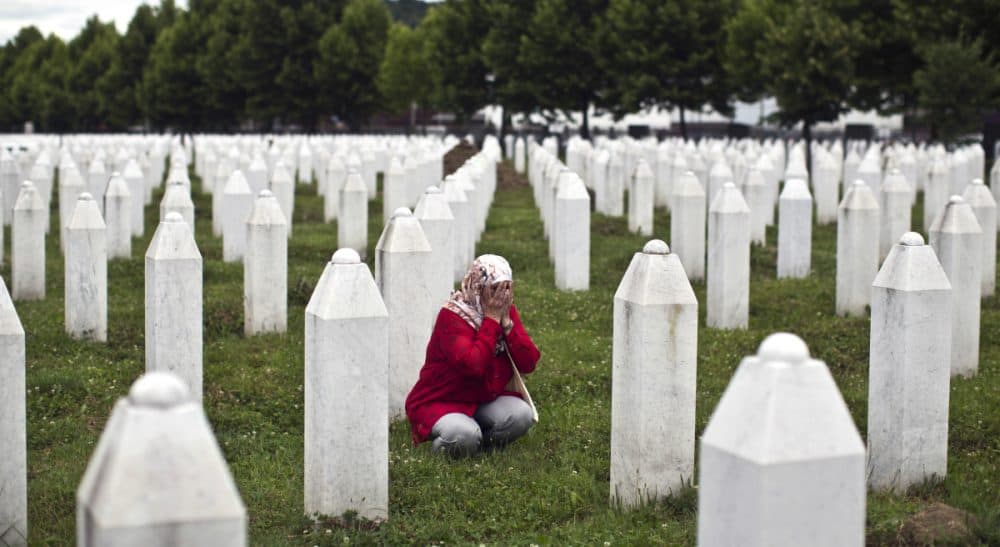Advertisement
20 Years Later, The Lingering Shame And Lost Lessons Of Srebrenica

Srebrenica is still very much with us. But as dignitaries affirm its importance as the worst massacre in Europe since the mass exterminations in the Nazi camps, and as Russia, through its shameful UN veto, tries to deny it was a genocide, the world has yet to fully learn its lesson.
Twenty years after Bosnian Serb soldiers hunted more than 8,000 Muslim men and boys through a forest, and beat them to death in an old factory while bulldozers plowed under the corpses to hide the evidence, Western powers have been unable to develop a winning formula for intervening in foreign conflicts, and Islamist extremists have become just like the Bosnian Serbs of Srebrenica.
Twenty years after Bosnian Serb soldiers hunted more than 8,000 Muslim men and boys through a forest...Western powers have been unable to develop a winning formula for intervening in foreign conflicts.
Srebrenica, a small mining town carved by a river between two rocky mountains on the eastern side of Bosnia-Herzegovina, had been a flash point since the beginning of the war in 1992 that raged between Muslim, Catholic Croat and Orthodox Serb forces over the independence of Bosnia from Yugoslavia. The town was overwhelmed with thousands of Muslim refugees who had been forced from their homes by Serbs as they seized territory. At its peak, there were 40,000 refugees in the town and surrounding villages.
The United Nations declared it a safe area and assigned a protective force of international soldiers to prevent the Serbs from attacking the Muslims. But the small force never gained complete control of Srebrenica. Bosnian Serb soldiers rained shells down upon the schoolyard where children played, they sniped at pedestrians, and they blocked UN convoys filled with food and medicine. The Muslim irregulars and Bosnian Government forces kept a stash of weapons, small in comparison to what their opponents had, which they used to raid surrounding Serb villages at night. But they never had enough to fight off a full attack, and there weren’t enough UN troops to protect them.
Islamist extremists cite Srebrenica as one of many grievances, including the wars in Iraq and Afghanistan, to justify their call for violent Jihad against the West. They say the U.S. and Europe denied the Muslims weapons and assistance to defend themselves. It's true that after a weapons embargo was created early in the war, aid from the West mostly came in food and medical assistance. Serious military intervention did not arrive until after Srebrenica.
During his trial on terrorism-related charges, Egyptian-born cleric Abu Hamza al-Masri vowed to train Muslims to defend themselves after seeing the dead of Srebrenica who had been abandoned by their government and outside forces. Al-Masri was later convicted and sentenced to life in prison, in part for establishing an al Qaeda-style training camp in Oregon.
Many Western powers have apologized for not protecting the Muslim refugees in the so-called safe area. President Obama has been mindful not to commit another grievance that Islamist extremists and those who would wage terror could add to their list, but his tepid early response to Syria mimics what happened in Bosnia. There was no meaningful intervention in Syria until Islamic State gained ground and stretched its fist toward Iraq. It wasn’t until what the UN has described as the possible genocide of the Yazidis in Iraq, that the US began serious military intervention. According to a UN report, last summer IS massacred 5,000 Yazidi men and detained 5,000–7,000 Yazidi women as slaves or forced brides in northern Iraq.
President Obama has been mindful not to commit another grievance that Islamist extremists...could add to their list, but his tepid early response to Syria mimics what happened in Bosnia.
As the U.S. and its allies increase intervention in Syria, they should remember that Srebrenica occurred after the U.S. military had begun to train the Serbs’ adversaries. In the spring of 1995, freshly armed and invigorated Croat and Bosnian Government forces marched through Serb-held territory in Croatia and Western Bosnia. The Bosnian Serbs needed more troops to staunch their battlefield losses. Their Drina Corps was tied down with managing the UN’s safe areas, which included Srebrenica. In order to free up the Drina Corps to fight out west, Bosnian Serb leader Radovan Karadzic signed Directive No. 7, in which he ordered the Bosnian Serb Army “to create an unbearable situation of total insecurity with no hope of further survival or life for the inhabitants of Srebrenica and Zepa.” Karadzic awaits a verdict following his trial for war crimes at The Hague.
The arc of events leading up to the massacre at Srebrenica warns us that IS is likely to commit more mass atrocities as the U.S. and its allies increase their bombing campaign in Syria and Iraq. It would be wise to identify vulnerable populations filled with the many religious groups that IS has said it despises and to plan how they could be defended so that we can at least try to avoid more Srebrenicas.
